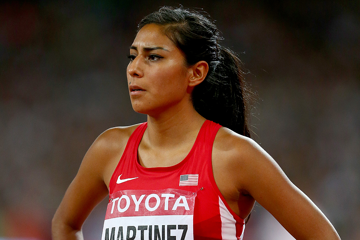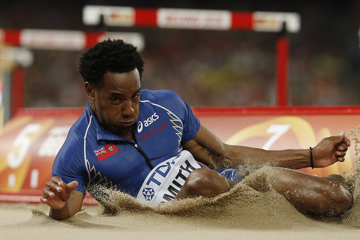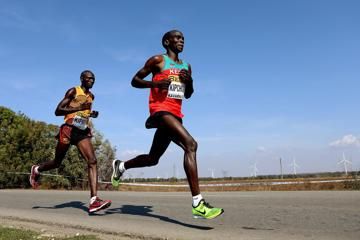Trey Hardee in the decathlon javelin at the 2011 IAAF World Championships (© Getty Images)
Trey Hardee suffered a serious elbow injury en route to the 2011 world decathlon title. The recently retired US all-rounder talks about the long, hard road to recovery and the enormous pride he felt on bouncing back to take Olympic silver in 2012.
Badly timed injury
“My greatest challenge had to be when I tore my elbow at the 2011 World Championships in Daegu and I barely had any time to make the Olympic team for London.
“The injury to the ulnar collateral ligament (UCL) happened during my third javelin throw in Daegu. At the time, I was leading the competition from Ashton Eaton and I was running faster, crossing over harder and hitting a better position (in the javelin) than I’d ever done before. In the first round, I threw a PB of 68.99m but on my third throw I heard my right elbow pop. I’d never experienced a ligament tear like that before.
“I only had one hour and 15 minutes to get ready for the 1500m and at that stage there was not a lot I could do. I took a painkiller and taped up the elbow to 90 degrees, so I ran like a robot. In the end running this way was not bad because the pain acted as a good distraction from the process of the race. I crossed the line in 4:45.68 – which was some way short of what I could have run – but I had won the gold by 102 points from Ashton.
“An MRI scan was set up on my return home, but before that I knew something was seriously wrong when I threw a hammer about five feet to a friend when we were putting together a headboard and I felt immense pain. Even more so than I’d experienced in Daegu.
“After the MRI scan revealed the damage, I sought out Dr James Andrews, a famous surgeon in my home town of Birmingham, Alabama, to carry out surgery. He himself was a former pole vaulter who has rehabbed famous NFL athletes back to top form after shoulder and elbow injuries.
“Surgery was declared a success and then it was ‘operation straighten my arm out’. From that point on I was rehabbing every single day or any spare moment. I calculated for the first three months following surgery, I had carried out 45,000 repetitions on my right side and as I’d also do everything on my left side too that was 90,000 repetitions in total.
“Training was tricky. I couldn’t lift weights, I couldn’t do push ups, I couldn’t swim or do any cross training. Six weeks after surgery I was told I could run, albeit with a heavy brace on my arm.
“I knew at the US Olympic Trials it would come down to the javelin but to give myself some wriggle room I knew I needed to be the best possible shape I could be for the other nine events. I was determined to be as fit as possible, so if it came down to the 1500m, I’d be ready. Training was not pretty. It was not like I had many flashes of brilliance and only two weeks before US Olympic Trials I threw a javelin for the first time since Daegu. It landed at 50m.
“At the US Trials, after Ashton set a world decathlon best in the long jump, I was in a fight for second (Eaton went on to set a decathlon world record 9039) and I decided to concentrate on myself and take it one event at a time. In the javelin, which I hit harder than at any point since Daegu, it went out to 57.00m. As soon as it landed, I ripped off my brace and ran around like I’d just won the lottery.
“I finished second at the trials and bearing in mind the year I’d experienced it was a really neat feeling to be on the team for London.
“I knew I’d been given a gift and a bunch of chips just by making the team and it was like I’d been given the house money, so I could just enjoy myself in London. I recall the weather was great, the fans were great and the atmosphere in the stadium was amazing because Team GB were on a roll. It was a fun place to go and compete. Every volunteer was so nice and helpful. I have nothing but great memories. It was special for me to go there and win silver.”
Steve Landells for the IAAF








